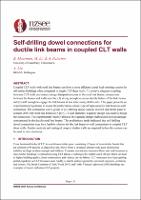| dc.contributor.author | Moerman, Ben | |
| dc.contributor.author | Li, Minghao | |
| dc.contributor.author | Palermo, Alessandro | |
| dc.contributor.author | Liu, Angela | |
| dc.date.accessioned | 2021-06-22T04:02:01Z | |
| dc.date.available | 2021-06-22T04:02:01Z | |
| dc.date.issued | 2021-04-14 | |
| dc.identifier.uri | https://repo.nzsee.org.nz/xmlui/handle/nzsee/2402 | |
| dc.description.abstract | Coupled CLT walls with steel link beams can form a more efficient lateral load resisting system for tall timber buildings when compared to single CLT shear walls. To achieve adequate coupling between CLT walls and ensure energy dissipation occurs in the steel link beams, connections between the beams and walls must be: (1) strong enough to ensure ductile failure of the link beams and (2) stiff enough to engage the link beams at low inter-storey drift levels. This paper presents an experimental programme to assess the performance of one type of high-capacity link beam-to-wall connection. The connection used a group of self-drilling dowels and an inserted steel knife plate to connect 200UB18 steel link beams to 5-ply CLT wall elements. Capacity design was used to design the connection. The experimental results validated the capacity design method and showed damage concentrated in the ductile steel link beams. This preliminary study indicated that self-drilling dowel connections may be a feasible solution for the link beam-to-wall connections in coupled CLT shear walls. Further analysis and testing of coupled timber walls are required before this system can be used in new structures. | |
| dc.language.iso | en | |
| dc.publisher | New Zealand Society for Earthquake Engineering | |
| dc.relation.ispartofseries | 2021;0050 | |
| dc.subject | Innovative approaches in seismic design and assessment | |
| dc.title | Self-drilling dowel connections for ductile link beams in coupled CLT walls | |
| dc.type | Article | |

